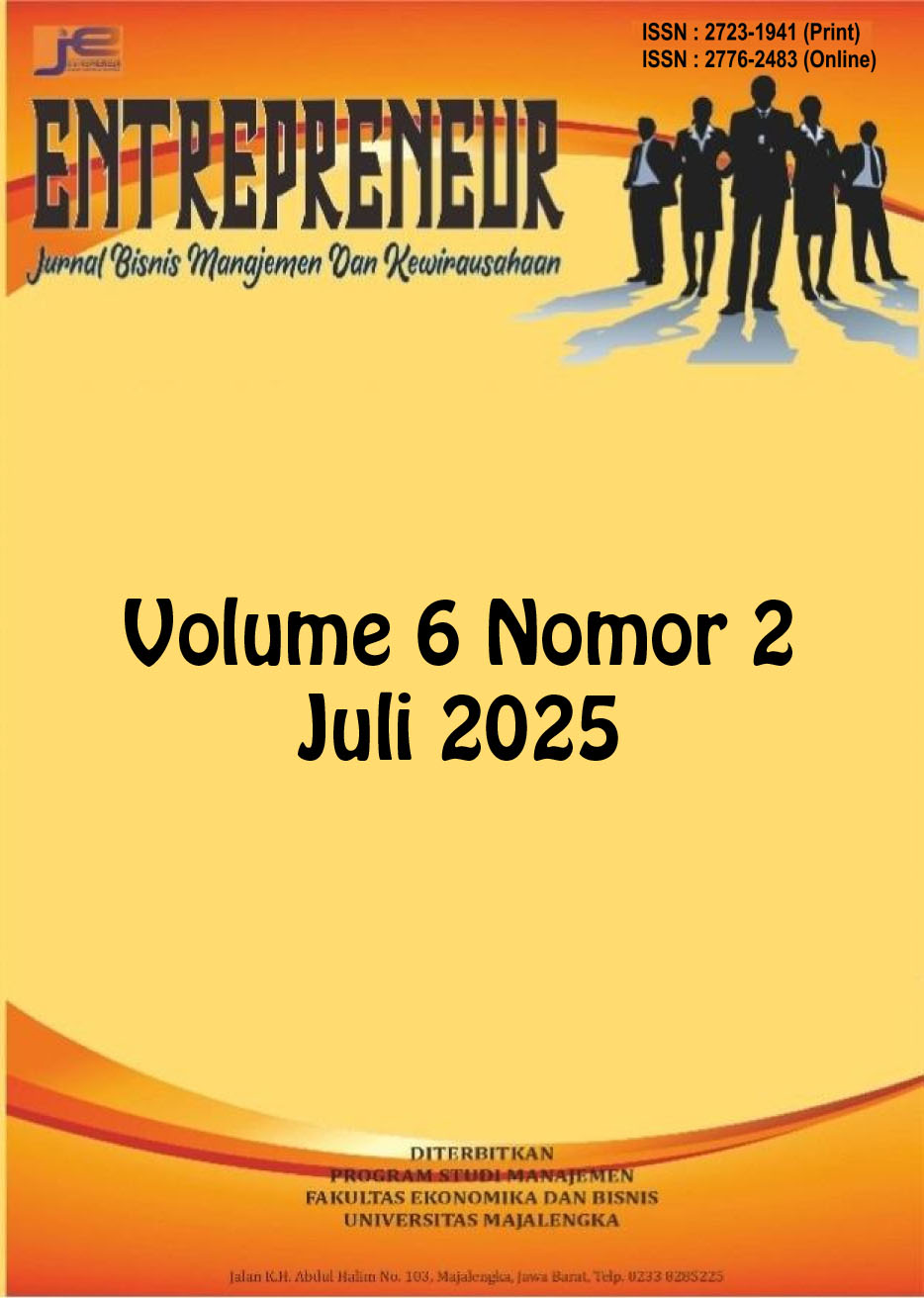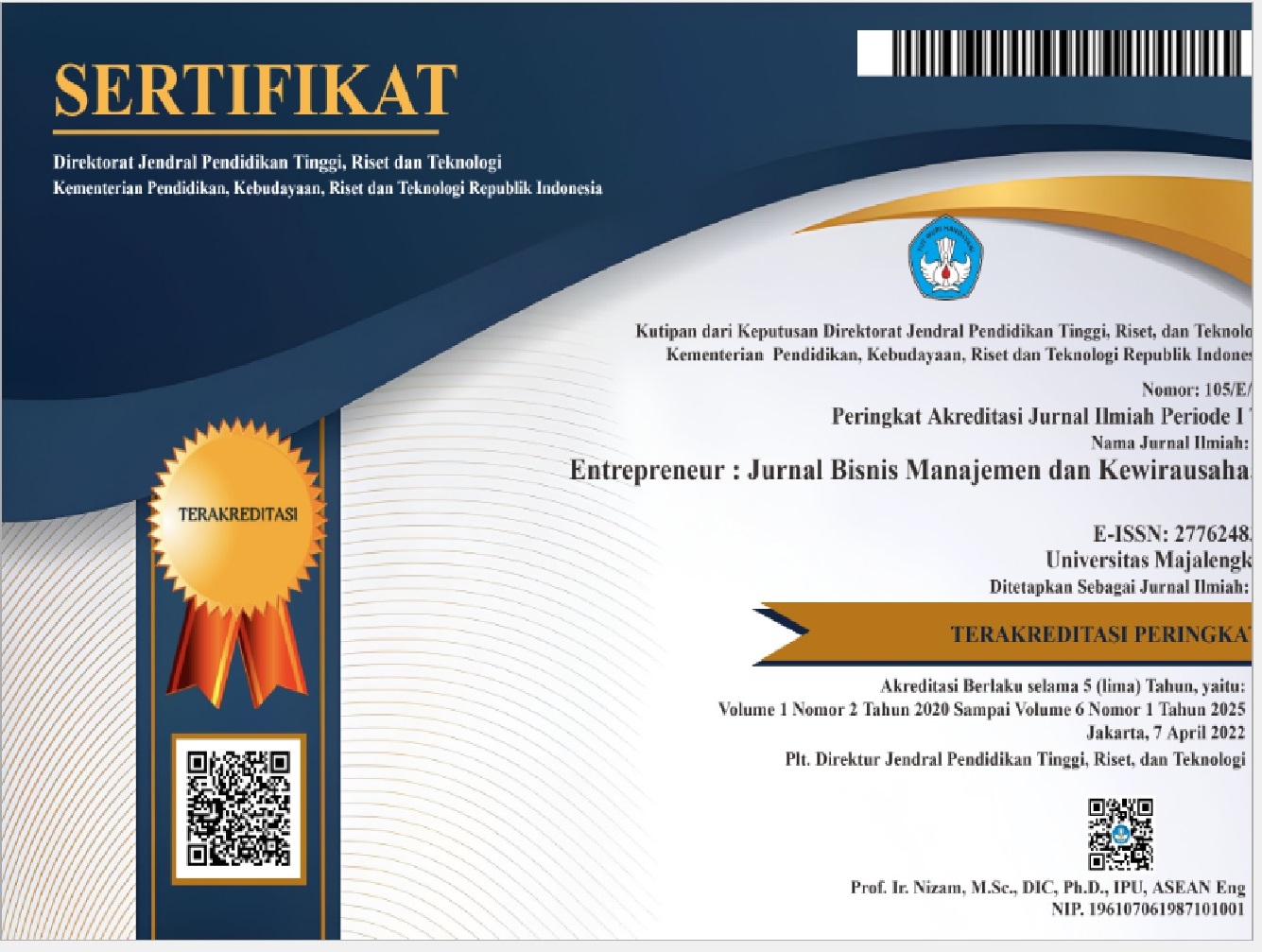Peran Kepuasan Kerja Dan Komitmen Organisasi Dalam Memediasi Pengaruh Employee Engagement Terhadap Intention To Stay Guru Gen Z SD/MI di Kecamatan Srono
DOI:
https://doi.org/10.31949/entrepreneur.v6i2.15064Abstract
Generation Z was often known as a dynamic generation that easily switched jobs. However, a different phenomenon was observed among Gen Z teachers in SD/MI in the Srono District, who showed a strong desire to remain in their profession. This study explored the factors that encouraged such loyalty, focusing on the role of employee engagement and how job satisfaction and organizational commitment served as bridges that strengthened their intention to stay. A quantitative approach was employed through questionnaire distribution and data analysis using the Structural Equation Modelling (SEM-PLS) technique. The results indicated that teachers’ involvement in their work (employee engagement) had a positive and significant influence on their intention to stay, both directly and indirectly through organizational commitment. Meanwhile, the indirect effect through job satisfaction was found to be insignificant. These findings conveyed an important message: when teachers felt valued, involved, and supported by their work environment, they developed into educators who not only stayed but also committed themselves to continuously serve and grow with their institutions.
Keywords:
employee engagement, Generation Z teachers, intention to stay, job satisfaction, organizational commitmentDownloads
References
Agustina, R., Farida, N., Wicaksono, S., Rahmawati, Y., Istiani, A., & Arnidha, Y. (2020). Experimentation of problem-based learning model on critical thinking ability in learning number theory. Journal of Physics: Conference Series, 1467(1), 12035.
Allen, N. J., & Meyer, J. P. (1990). The measurement and antecedents of affective, continuance and normative commitment to the organization. Journal of Occupational Psychology, 63(1), 1–18. https://doi.org/10.1111/j.2044-8325.1990.tb00506.x
Ardiansyah, F., & Budiono, B. (2022). Pengaruh Kompensasi terhadap Employee engagement dan Dampaknya pada Employee Performance. Jurnal Ilmu Manajemen, 10(1), 110–122. https://doi.org/10.26740/jim.v10n1.p110-122
Bakker, A. B., & Demerouti, E. (2008). Towards a model of work engagement. Career Development International, 13(3), 209–223. https://doi.org/10.1108/13620430810870476
Creswell, J. W. (2014). Research Design: Qualitative, Quantitative and Mixed Methods Approaches (4th ed.). Sage.
Dwiputri, R., Rumijati, A., & Utama, E. K. (2023). The effect of organizational climate on intention to stay with employee engagement as intervening variable. Jurnal Manajemen Bisnis Dan Kewirausahaan, 2(3), 45–58. https://doi.org/10.22219/jamanika.v2i03.22750
Effect, T. H. E., Perceived, O. F., Support, O., Intention, O. N., Stay, T. O., By, M., & Satisfaction, J. O. B. (2024). ORGANIZATIONAL SUPPORT ON INTENTION. 22(2), 476–491.
Firmansyah, M., & Rahayu, D. (2022). Analisis faktor-faktor yang memengaruhi intention to stay pada tenaga pendidik generasi muda. Jurnal Pendidikan Dan Manajemen, 9(2), 115–130.
Gallup. (2023). State of the Global Workplace: 2023 Report. https://www.gallup.com/workplace/349484/state-of-the-global-workplace.aspx
Hair, J. F., Anderson, R. E., Tatham, R. L., & Black, W. C. (1995). Multivariate Data Analysis with Readings (4th ed.). Prentice Hall.
Harter, J. (2018). Employee engagement on the rise in the US. Gallup Poll News Service.
Hidayanti, F., nur aini, S., & Wibowo, D. (2024). Pengaruh Komitmen Organisasi Terhadap Turnover Intention Generasi-Z Yang Bekerja Sebagai Guru SMK. JIGC (Journal of Islamic Guidance and Counseling), 8, 48–61. https://doi.org/10.30631/jigc.v8i1.91
Hidayatullah, M., Hatami, H., & Fauziannor, A. (2025). Retensi Karyawan Generasi Z Di Indonesia Berdasarkan Kajian Literatur Sistematis. Jurnal Kajian Dan Penalaran Ilmu Manajemen, 3, 1–16. https://doi.org/10.59031/jkpim.v3i2.601
Kementerian Pendidikan, Kebudayaan, Riset, dan Teknologi (Kemendikbudristek). (2023). Laporan statistik pendidikan nasional 2023. Pusat Data dan Statistik Pendidikan.
Luthans, F., & Peterson, S. J. (2002). Employee engagement and manager self-efficacy. Journal of Management Development, 21(5), 376–387.
Luthfiana, N., Zamralita, Z., & Idulfilastri, R. M. (2023). Peran Kesejahteraan di Tempat Kerja terhadap Keinginan untuk Tetap bertahan pada Milenial. GUIDENA: Jurnal Ilmu Pendidikan, Psikologi, Bimbingan Dan Konseling, 13, 999–1007. https://doi.org/10.24127/gdn.v13i4.8261
Mufidawati, H., & Desiana, P. M. (2024). Predicting Gen Z ’ s Intention to stay : The Role of Workplace Fun , Psychological Capital , and Work Engagement. 17(3), 415–431.
Ng, T. W. H., & Feldman, D. C. (2010). The relationships of age with job attitudes: A meta-analysis. Personnel Psychology, 63(3), 677–718. https://doi.org/10.1111/j.1744-6570.2010.01184.x
Octavia, D. H., & Budiono, B. (2021). Pengaruh Teamwork terhadap Kinerja Karyawan melalui Job Satisfaction. Jurnal Ilmu Manajemen, 9(3), 954–965. https://doi.org/10.26740/jim.v9n3.p954-965
Priatna, S. F., Emilisa, N., & Khairana, S. (2024). Faktor – Faktor yang Mempengaruhi Organizational Citizenship Behaviour Pada Karyawan Mandiri University Group. 22(3). https://doi.org/10.26623/slsi.v22i4.9592
Robbins, S. P., Judge, T. A., & Judge, T. (2019). Organizational Behavior. Pearson. https://books.google.co.id/books?id=_cwqtgEACAAJ
Robinson, D., Perryman, S., & Hayday, S. (2004). The drivers of employee engagement. Institute for Employment Studies.
Saks, A. M. (2006). Antecedents and consequences of employee engagement. Journal of Managerial Psychology, 21(7), 600–619. https://doi.org/10.1108/02683940610690169
Sari, S. N., Safitri, A., Mahrizal, M., Wulandari, A. R., Sinaga, V. L., & Mulyani, N. (2025). Analisis pengaruh lingkungan kerja, work engagement dan work life balance terhadap motivasi kerja tenaga pengajar. Edu Cendikia: Jurnal Ilmiah Kependidikan, 4(03), 1333–1339. https://doi.org/10.47709/educendikia.v4i03.5220
Schaufeli, W. B., & Bakker, A. B. (2004). Job demands, job resources, and their relationship with burnout and engagement: A multi-sample study. Journal of Organizational Behavior, 25(3), 293–315. https://doi.org/10.1002/job.248
Stamolampros, P., Korfiatis, N., Chalvatzis, K., & Buhalis, D. (2020). Job satisfaction and employee turnover determinants in the hospitality industry: A global perspective. Tourism Management, 81, 104241. https://doi.org/10.1016/j.tourman.2020.104241
Sugiyono. (2013). Metode Penelitian Pendidikan: Pendekatan Kuantitatif, Kualitatif dan R&D. Alfabeta.
Sugiyono. (2016). Metode Penelitian Kuantitatif, Kualitatif, dan R&D. Alfabeta.
Tett, R. P., & Meyer, J. P. (1993). Job satisfaction, organizational commitment, turnover intention, and turnover: Path analyses based on meta-analytic findings. Personnel Psychology, 46(2), 259–293. https://doi.org/10.1111/j.1744-6570.1993.tb00874.x
Truss, C., Delbridge, R., Alfes, K., Shantz, A., & Soane, E. (2013). Employee engagement in theory and practice. Routledge London.
Undang-Undang Republik Indonesia. (2003). Sistem Pendidikan Nasional Nomor 20 Tahun 2003 Tentang Sistem Pendidikan Nasional. UNDANG-UNDANG REPUBLIK INDONESIA. https://peraturan.bpk.go.id/Details/43920/uu-no-20-tahun-2003
Wildan, A. I. (2024). YUME : Journal of Management Pengaruh Employee Engagament terhadap Intention to stay di Industri Teknologi. 7(3), 1556–1565.
Zeffane, R. (1994). Patterns of organizational commitment and perceived management style: A comparison of public and private sector employees. Human Relations, 47(8), 977–1010. https://doi.org/10.1177/001872679404700806

Published
How to Cite
Issue
Section
License
Copyright (c) 2025 Ahmad Fauzi, Yuniorita Indah Handayani, Lia Rachmawati

This work is licensed under a Creative Commons Attribution-ShareAlike 4.0 International License.
COPYRIGHT NOTICE
An author who publishes in the Entrepreneur: Jurnal Bisnis Manajemen dan Kewirausahaan agrees to the following terms:
1. Author retains the copyright and grants the journal the right of first publication of the work simultaneously licensed under the Creative Commons Attribution-ShareAlike 4.0 License that allows others to share the work with an acknowledgment of the work's authorship and initial publication in this journal
2. The author is able to enter into separate, additional contractual arrangements for the non-exclusive distribution of the journal's published version of the work (e.g., post it to an institutional repository or publish it in a book) with the acknowledgment of its initial publication in this journal.
3. The author is permitted and encouraged to post his/her work online (e.g., in institutional repositories or on their website) prior to and during the submission process, as it can lead to productive exchanges, as well as earlier and greater citation of the published work







